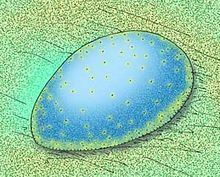Kingdom Animalia Scientific name Solza margarita | Genus †Solza
Ivantsov, 2004 Rank Species | |
 | ||
Similar Onega stepanovi, Vaveliksia, Tamga, Lossinia, Vendia | ||
Solza margarita is an extinct animal of uncertain phylogeny which lived about 555 mya in the Ediacaran period.
Contents
Occurrence
Fossils of the Solza margarita is found in the Verkhovka and Zimnegory formations on the Solza River and Zimnii Bereg (Winter Coast), White Sea area of the Arkhangelsk Region, Russia.
Etymology
The generic name Solza comes from the Solza river on the Onega Peninsula, White Sea, where the holotype and first specimens were found. The specific name, margarita, derives from the Greek μαργαριτηζ (margarita), meaning "pearl".
Description
Solza was shape of a low oblique cone with a base, which is egg-like in cross-section. Fossil impressions is covered by the meshwork of grooves, which is wide at the apex of the cone, narrowing and diverging towards the animal's edges.
In the first description it was suggested that the grooves were formed postmortem above cavities inside the body or they covered the body surface during the animal’s life.
Described specimens of Solza range from 7.2–10.5mm in length, and 5.3–8mm wide. Most specimens show slight distortion, but preserve the basic egg-shape, implying that Solza had at least some firmness.
Behavior
Fossil specimens easily demonstrate that Solza was a benthic, bilaterally symmetric organism: thus, it was likely a motile, mobile animal that adhered to the substrate.
